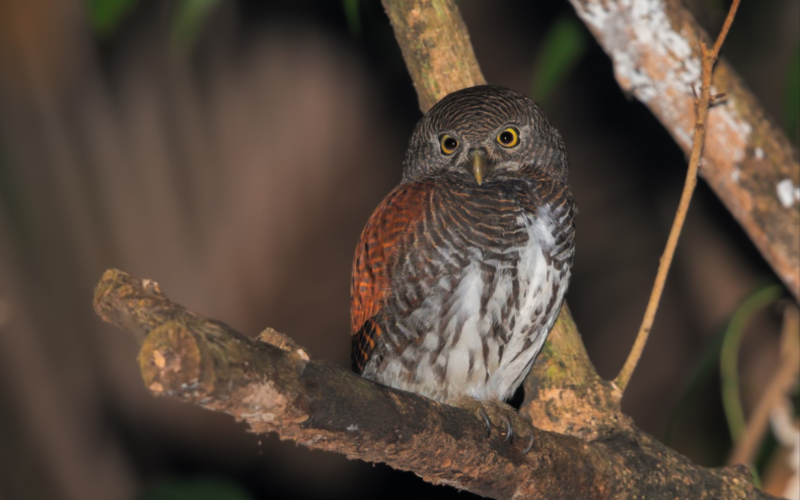About Chestnut Backed Owlet
The Chestnut-backed Owlet (Glaucidium castanotum) is a small, elusive bird of prey found only in Sri Lanka. This species is known for its striking chestnut and black plumage, as well as its distinctive calls and hunting habits. Despite being one of the rarest and least-known owl species in the world, the Chestnut-backed Owlet is a fascinating and important part of Sri Lanka’s rich biodiversity.
Appearance and Range OF Sri Lanka Chestnut-Backed Owlet
The Chestnut-backed Owlet is a small owl, measuring just 15 cm in length and weighing around 60 grams. Its striking plumage is primarily chestnut-brown on the back and wings, with black stripes on the head, neck, and upper breast. The underparts are pale with dark spots, and the eyes are large and yellow. The bird’s call is a distinctive series of high-pitched whistles, often given in a duet between a male and female.
The Chestnut-backed Owlet is endemic to Sri Lanka, meaning it is found nowhere else in the world. Its range is limited to the island’s central highlands, where it inhabits montane evergreen forests at elevations of 1,500 to 2,000 meters. The species is considered threatened due to habitat loss and fragmentation and is currently listed as Vulnerable by the International Union for Conservation of Nature (IUCN).
Behavior and Ecology OF Sri Lanka Chestnut-Backed Owlet
The Chestnut-backed Owlet is a nocturnal predator, feeding on a variety of small prey including insects, spiders, and small mammals such as rodents and shrews. Like other owls, it has excellent night vision and hearing and uses its sharp talons to capture prey. The bird is also known for its distinctive hunting behavior, which involves perching low on tree branches and pouncing on prey from a stationary position.
Little is known about the Chestnut-backed Owlet’s breeding habits, but it is believed to mate for life and to lay two to three eggs in a clutch. The species is thought to be monogamous, with pairs defending territories and communicating with each other using their distinctive calls.

Where Can You Find Chestnut-Backed Owlet
- Sinharaja Rain Forest
- Kitulgala Forest Reserve
- Kanneliya Forest Reserve
Conservation Status and Threats
The Chestnut-backed Owlet is threatened by habitat loss and fragmentation, as forests in Sri Lanka’s highlands are cleared for agriculture, logging, and development. In addition, the species is vulnerable to climate change, which could affect the availability of prey and disrupt its breeding patterns.
Conservation efforts for the Chestnut-backed Owlet are focused on protecting its remaining habitat, as well as raising awareness about the bird’s importance and vulnerability. The species is protected by law in Sri Lanka, and conservation organizations are working to establish protected areas and promote sustainable land use practices in its range.
Conclusion
The Chestnut-backed Owlet is a fascinating and important part of Sri Lanka’s biodiversity, with its distinctive appearance and behavior making it a popular subject for birdwatchers and conservationists. Despite being one of the world’s rarest and least-known owl species, the Chestnut-backed Owlet is a reminder of the incredible diversity of life on our planet, and the urgent need to protect it. Through conservation efforts and public awareness, we can help ensure that this unique bird and its habitat are preserved for future generations.

